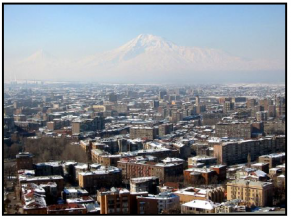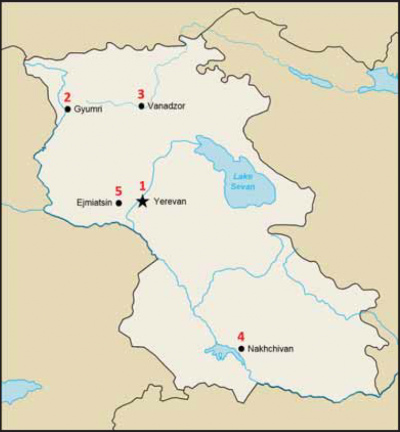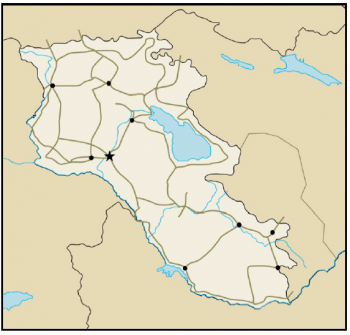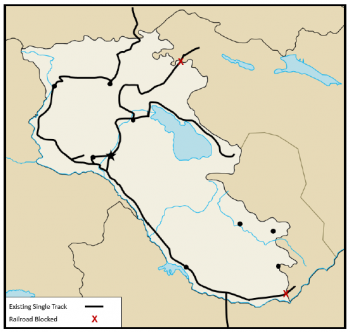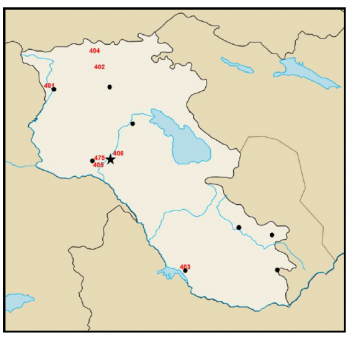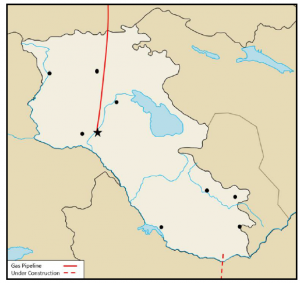Infrastructure: Limaria
While the region’s five countries have a significant number of rural residents, the majority of each country’s population lives in urban areas. About two-thirds of the Arianian (68%), Donovian (67%), and Limarian populace (64%) and just over half of the Gorgan (53%) and Atropian (52%) populace live in urban areas. All five countries contain a mixture of modern urban cities and almost pre- modern rural villages. Modern utilities can be found in most major cities but not in the rural villages and countryside.
Nearly two-thirds of Limarians live in cities, with over one-third of them located in the capital city, Yerevan. Limaria remains an urban country still surviving on the infrastructure built over two decades ago. With little natural resources, the country does not possess the economic means to maintain its current infrastructure, let alone build new infrastructure. Most rural and many urban Limarians cannot access the three basic utilities—electricity, potable water, and sewage disposal. With limited funds, it remains likely that Limaria will continue to struggle with the maintenance of its current infrastructure. Due to problems in the infrastructure and other reasons, Limaria faces a negative urbanization rate as some of the people chose to return to the country to become subsistence farmers. Even though rural people may not possess the same standard of living as those in the urban areas, the farmers will not starve. Limaria would like to become involved in the hydrocarbon pipeline distribution system that surrounds its country, but the possibility of potential conflicts keeps investors at bay.
As previously mentioned, the majority of residents in all five countries live in urban areas. Most urban cities contain a mixture of old neighborhoods with roughshod construction, while buildings in newer neighborhoods were made with modern construction methods. In rural villages and areas, residents use whatever materials they can obtain to build their houses.
Like Gorgas and Atropia, Limarian urban construction patterns reflect mostly Donovian influenced architecture except for their inner city core. Dense random construction built up since the city’s formation shapes each city’s original neighborhoods. Limaria’s largest cities built multi-family buildings to house the urban residents in a closed orderly block construction. In areas near factories, apartment buildings create strip area neighborhoods. Newer construction shows more signs of Western influence.
With only three cities over 100,000 people, most Limarians live in smaller cities or in rural areas, where 46.2% of the population support themselves in a job related to the agricultural industry. Except for Yerevan, military operations in Limaria will likely not require extensive urban operations. This will probably reduce the numbers of displaced civilians in most military operations and will also likely mitigate the possibility that the military will need to support large numbers of civilians with food. The major exception would occur in the Yerevan metropolitan area.
Major Cities and Urban Zones
Almost two-thirds of Limarians live in urban areas, but 46.2% of the people work in agriculture- related fields. Over one-third of Limarians live in its capital city, Yerevan. Limaria only has five cities with over 50,000 residents, and only three of them contain over 100,000 residents.
Yerevan
With over 1.1 million in Yerevan and another 200,000 in the metropolitan area, over one-third of all Limarians live in the vicinity of Limaria’s capital city. Yerevan possesses two airports, 46 bus lines, 24 trolley lines, and a subway system with 10 stations. The only train line operates to Gorgas to the north due to Atropian blockades in the other directions. Besides serving as Limaria’s financial center, other major businesses include chemicals, metals, machinery, textiles, alcoholic beverages, and processed food.
Seventy-one of Limaria’s 90 institutes of higher learning are in Yerevan. Yerevan contains a dense, randomly constructed old city that creates a city core urban zone with its adjacent core periphery urban zone. While Yerevan contains many new buildings because of a building boom in the 1980s, the blocks do not conform to a typical Western grid pattern, but spring up haphazardly based on the terrain and the builders’ preferences. Yerevan also contains many low-rise residential areas and commercial areas. A large number of industrial areas surround the city. The Limarian military locates several of its key military units not in support of the breakaway Atropian province of Lower Janga in the Yerevan metropolitan area.
Gyumri
Limaria’s second-largest city, Gyumri, only contains about 160,000 people and lies approximately 80 road miles northwest of Yerevan. Located along the Akhuryan River, Gyumri suffers from very cold winters and warm summers as a result of its elevation. Gyumri contains an old city with dense random construction, and organized block areas with large apartments built from the 1950s to the 1980s that form the city core and core periphery urban zones. Gyumri shows signs of Western-style grid block construction that creates both high-rise and low-rise residential areas. Some industrial areas exist, along with the expected number of commercial areas for a city of its size.
Vanadzor
At 109,640 people, Vanadzor claims the distinction as Limaria’s third-largest city. Vanadzor lies approximately 55 road miles directly north of Yerevan, and many consider it Limaria’s most picturesque city. The chemical industry serves as Vanadzor’s primary business and creates a large industrial area for a city of its population. Commercial areas exist that support the residents and the city’s two schools of higher learning. Unlike many other old cities, Vanadzor’s downtown does not contain dense random construction, but relatively wide streets built in the 1950s and 1960s to create only a core periphery urban zone.
Nakhchivan
Nakhchivan (population 70,400) ranks as Limaria’s fourth-largest city and lies approximately 100 miles southeast of Yerevan. Nakhchivan contains all six civilian urban zones: city core, core periphery, high-rise residential, low-rise residential, commercial, and industrial areas in the typical three-ring pattern—core, residential/commercial, and industrial—from the city center.
Military operations in Nakhchivan may require extensive urban operations to support house-to- house fighting found in dense inner city cores. The city also contains a number of large apartment buildings that the military may need to clear room by room. Nakhchivan may provide some limited logistical support to foreign military.
Ejmiatsin
Ejmiatsin, Limaria’s fifth-largest city, lies fewer than 15 miles due west of Yerevan. The city contains about 57,000 people and primarily supports the agriculture industry, as it is totally surrounded by farms. Ejmiatsin contains a small city core urban zone, a smaller core periphery urban zone, and mostly low-rise residential area. Limited commercial areas exist, with only a small number of industrial areas and almost no high-rise residential areas.
Population Density
- Yerevan: 12,681 people per square mile
- Gyumri: 8,425 people per square mile
- Vanadzor: 10,857 people per square mile
- Nakhchivan: 12,816 people per square mile
- Ejmiatsin: 3,354 people per square mile
Utilities Present
The Caucasus area faces a dichotomy when it comes to utilities such as electricity, water, and sewage treatment. Most urban households can access modern utilities, but rural areas cannot. Many rural residents who cannot access modern utilities live similarly to their ancestors generations ago.
Power
Another dichotomy in the Caucasus region is that countries like Ariana, Atropia, and Donovia export hydrocarbons, coal, or electrical power to other countries while Gorgas and Limaria must import the same resources to meet their requirements. The countries that can export hydrocarbon products or electricity become richer while those that must import significant quantities of power become poorer. At least 75% of all structures in the five countries can access power because they are located in urban areas.
Limaria is another country with a dearth of hydrocarbon resources in the Caucasus region, as it produces no crude oil or natural gas and does not export any oil, natural gas, or coal. In the previous five years, Limaria increased its natural gas imports almost 25% (60 to 73 billion cubic feet), but it dropped during the last calendar year to 68 billion cubic feet. Coal consumption demonstrates a similar graph, as it increased from 88,000 short tons for five consecutive years to 110,000 short tons before a drop to 66,000 short tons in the last calendar year. In the five years previous to that,
Limaria’s electricity generation dropped slightly (5.977 to 5.584 billion kilowatt hours), while increased electricity imports covered the rise in electrical usage during the time period. Over the last six years, Limaria shows a general trend with a slight increase in power production imports each year.
Limaria contains no known hydrocarbon resources and few coal deposits, so it will always remain reliant on other countries for a large portion of its energy needs. The country generates 24% of its electricity from three thermal power plants located at Vanadzor, Hrazdan, and Yerevan. Limaria receives another 33% of its electricity from nine hydroelectric power plants located throughout the country. Most of Limaria’s other electricity comes from 313 small hydroelectric plants scattered throughout the country. The country currently possesses only one wind power plant, but plans for additional plants exist. Unless Limaria finds a way to produce more electricity from hydropower, the country will not possess the necessary financial resources for modernization. Without electricity, Limaria’s rural areas will continue to obtain their power from inefficient generators or the burning of fossil fuels.
Water
The majority of the Caucasus region’s urban population has access to potable water. As areas become more rural, people must rely on local sources—rivers, streams, and wells—to obtain water for cooking, drinking, and washing.
While a majority of the residents in Limaria’s three largest cities—Yerevan, Gyumri, and Vanadzor—can access a modern water system, the numbers do not reach those of their neighboring countries. In Yerevan, about 85% of the residents can access safe drinking water. This number drops to 66% in Gyumri and 61% in Vanadzor. The more rural the area, the lower the percent of Limarians with access to potable water through modern means. As a result, Limarians suffer the effects of contamination found in rivers, streams, wells, and other ground water. Overall, approximately 70% of all Limarians can access a modern water system. Military personnel will need to check all water to determine its cleanliness before use, especially away from the very largest cities.
Sanitation
The vast majority of Ariana, Atropia, Donovia, and Gorgas urban residents use modern sewage disposal methods to get rid of waste, but most Limarians do not. Urban residents have greater access to modern sewage treatment than rural residents. The more remote a person, the less likely he/she will use modern sewage treatment techniques. Poor disposal methods in rural areas contaminate ground water that other residents rely on for drinking and cooking.
Like water, many Limarians cannot access a modern sewage system. In Yerevan, where almost one- third of the populace lives, only 24% can access a modern sewage system. The numbers appear better in Gyumri and Vanadzor where 66% and 51%, respectively, dispose of their waste through a modern sewage system. Rural Limarians have even fewer opportunities to access a modern sewage system than those in the urban areas, so the entire country’s overall access rate to a modern sewage system remains below 25%.
Transportation Architecture
Roads are the primary transportation method throughout the Caucasus region. Train and especially air travel remain too expensive for many residents of Ariana, Atropia, Gorgas, and Limaria. Most roads, especially the unpaved ones, suffer from a lack of maintenance. Ariana and Donovia maintain a complex transportation architectural system while the other three countries operate a moderate one due to railway system limitations.
Road Systems
Overall, roads in this part of the world do not meet US or Western Europe standards. Driving is hazardous, especially in the winter months or in bad weather. Generally, drivers do not obey all traffic laws, and vehicle owners often fail to maintain their vehicles properly.
Unlike most countries in the region, Limaria contains more paved than unpaved roads. Of the country’s 5,523 miles of road, paved roads account for 80% or 4,399 of the miles. Most of the roads, however, do not receive proper maintenance. While most roads remain passable, many need considerable repair work to meet Western standards. Limaria’s main road, called the Kajaran Highway, links Limaria to Ariana. Limaria also contains two major roads that link it to Gorgas, but these roads attract bandits who rob vehicles traversing them.
Bus
All five countries maintain some sort of bus system, but its quality depends on the country and location. The larger the city, the more likely it will operate a public bus system. Usually, intercity buses run between the larger cities, and “private” buses may also operate in some areas. Due to the relatively cheap cost of public transportation, buses remain a favorite method for local civilians to travel long distances within their country.
Limaria operates its bus system on a hub and spoke design. Each city operates buses that travel to smaller villages in the local area and also to other large cities. Mini-buses also operate in the same method except they do not sell tickets, as riders just pay the driver for the price negotiated.
Limaria’s largest bus system operates in its capital, Yerevan. Yerevan contains over 350 buses that move an estimated 150 million customers each year. The city also operates a large trolley fleet of 320 vehicles that moves 100 million riders each year. Yerevan’s public transportation system also runs a tram system with 150 cars.
Any military operation in Limaria will require an inspection of the buses for weapons and contraband. Additionally, any military activities in the Yerevan area will need to ensure the continued operation of the bus, trolley, and tram system. A major disruption to Yerevan’s public transportation system could drastically affect the local civilian populace due to its importance for civilian travel.
Rail
All five Caucasus countries operate a railroad system, but they suffer many problems due to maintenance issues, non-standard equipment, criminal activity, and high cost.
Limaria operates approximately 525 miles of railway track; most of it powered by electricity. Only two international train routes currently operate: one to Gorgas, and the other to Ariana. Due to the current conflict with Atropia over the Lower Janga region, the rail lines are blocked at all Atropian and Lower Janga borders. The Limarian railroad system suffers from poor maintenance and crime, which deter passengers from its use. Talks about improving the railroad system, however, recently occurred between Limaria and neighboring countries.
Yerevan operates a single subway line of about 8.5 miles and 10 stations. Discussions about an additional two lines recently stalled due to the construction cost. Over 50,000 people use the Yerevan metro system every day. Any military activities in the Yerevan area that disrupt the subway system could hurt the city economically. As with all subway systems, civilians could use the underground stations as air raid shelters.
Air Transportation Systems
All five countries maintain both paved and unpaved runways of varying distances. Many of the unpaved runways resemble nothing more than a cleared dirt path only suitable for the sturdiest of planes.
Limaria contains 11 runways throughout the entire country; all but one has a paved surface. The only unpaved runway in Limaria does not exceed 3,000 feet. The map indicates the location of the major Limarian hard surface runways, and the chart provides runway data (not all runways are shown on either the map or in the chart).
Paved Runways
- Over 10,000 feet: 2
- 8,000 to 10,000 feet: 2
- 5,000 to 8,000 feet: 0
- 3,000 to 5,000 feet: 4
- Under 3,000 feet: 2
Unpaved Runways
- Over 10,000 feet: 0
- 8,000 to 10,000 feet: 0
- 5,000 to 8,000 feet: 0
- 3,000 to 5,000 feet: 0
- Under 3,000 feet: 1
Major Runways
| Map # | Elevation (Feet) | Latitude (D, M, S) | Longitude (D, M, S) | Length (Feet) | Width (Feet) | Surface Type |
| 401 | 5000 | 40 45 06.00 N | 43 51 36.00 E | 10564 | 147 | Asphalt |
| 402 | 4846 | 41 02 59.04 N | 44 20 41.00 E | 6546 | 110 | Asphalt |
| 403-1 | 2863 | 39 11 19.70 N | 45 27 30.39 E | 10826 | 148 | Asphalt |
| 403-2 | 2863 | 39 11 19.70 N | 45 27 30.39 E | 10826 | 138 | Asphalt |
| 404 | 4836 | 41 02 54.42 N | 44 20 13.82 E | 6555 | 92 | Asphalt |
| 405 | UNK | 40 07 19.17 N | 44 27 54.33 E | 8694 | UNK | UNK |
| 406-1 | 4501 | 40 17 30.56 N | 44 34 06.74 E | 3295 | 250 | Concrete |
| 406-2 | 4501 | 40 17 30.56 N | 44 34 06.74 E | 3252 | 250 | Concrete |
| 407 | 2838 | 40 08 50.19 N | 44 23 45.17 E | 12629 | 184 | Asphalt |
Airports/Airlines
Limarian Airlines is Limaria’s national carrier and operates a fleet of 25 planes. The only Limarian Airlines plane that meets Western European standards to land is a leased Airbus A310. Limarian Airlines operates international flights from Zvartnots International Airport outside of Yerevan to a limited number of European countries. Anyone who flies Limarian Airlines should expect frequent delays, unexpected refueling stops, and poor service due primarily to insufficient maintenance practices.
Maritime Seaports
Without access to open sea, Limaria operates no ports and conducts very little transportation of goods on its rivers. Limaria must rely on its neighbors to export its products to other countries.
Pipelines
The security of hydrocarbon pipelines will be paramount in any military operations in the Caucasus region. Any disruption to the flow of crude oil and natural gas to the Western world could cause economic problems, as many modern countries rely on hydrocarbons to fuel their industries.
Since Limaria possesses no hydrocarbon resources, Donovia provides the bulk of Limaria’s natural gas through a pipeline that passes through Gorgas. Gorgas takes 10% of the natural gas bound for Limaria as a transit fee. Construction continues on a 122-mile-long pipeline that will carry natural gas from Tabriz, Ariana, to Ordubad, Limaria, where it will connect with the current distribution network.
Currently, no pipelines that export hydrocarbon products to Europe from the three oil- and gas-rich countries—Ariana, Atropia, and Donovia—cross Limaria, so the country receives no transit fees. Even though Limaria offers a shorter route, the unstable military situation in Limaria discourages companies from construction through a potential war zone. The European consortiums decided a safer option would be to construct additional gas and oil pipelines that follow the Trans-Caucasus petroleum (TC-P) and natural gas (TC-G) pipelines through Atropia and Gorgas, before reaching the European markets.
If military activities in Limaria interrupt the hydrocarbon transportation network, Limaria’s economy will come to a complete halt. Without its own oil and natural gas resources, Limaria remains reliant on its hydrocarbon-rich neighbors to supply its needs.
Telecommunications Architecture
For the most part, Caucasus-region residents use cellular telephones to communicate with each other due to the lack of landline telephone infrastructure. Many residents never owned any type of telephone until they received their first cellular phone. Most can access news from either television or radio, but some rural residents have no information access via modern methods. (See Information variable for additional details.)
Limaria contains sufficient telephones for almost every citizen, but the country does not show as much advancement in Internet connections as its neighboring countries. With about three million people, Limaria contains 650,000 landline telephones and 2.336 million cellular phones. The privatization and recent modernization of the old telephone system, built in the 1950s, caused the increase—with the result that now almost every Limarian can use a telephone. Only 36,354 Internet hosts operate in Limaria, and only about 191,000, or less than 7% of the citizens, access the Internet on a regular basis. That differs from Limarian governmental claims that 47% of its residents can access the Internet. Two public and over 35 private television stations operate in Limaria, providing almost total coverage to the entire country. Nine radio stations, both public and private, also operate throughout Limaria. The military will find that television serves as the best medium to reach the largest audience in Limaria.
Industry
Because of their hydrocarbon resources, Ariana, Atropia, and Donovia are more industrialized than Gorgas and Limaria. Industry GDP ranges from a low of 27.1% in Gorgas to a high of 61.4% in Atropia. Limaria produces 46.6% of its GDP from industry. The protection of the hydrocarbon infrastructure remains paramount for any military operations in the area, and the military should refrain from any unnecessary damage to the industrial sector to facilitate economic recovery after the end of hostilities.
Since the end of major Donovian influence, industries have become less important to Limaria, as many people returned to farming to prevent their family from starving. Lack of fuel and electricity decreased industrial production by 40% 19 years ago, primarily caused by the Atropian blockade. Before then, Limaria produced chemicals, petrochemicals, fertilizers, and building materials. Now, Limaria’s major products include knitted clothing and hosiery, canned goods, aluminum foil, and shoes. The country mines copper, zinc, molybdenum, gold, and lead, and contains small deposits of coal, gas, and petroleum, but delays plague their development. Limaria still possesses a large amount of toxic industrial chemicals from a couple of decades ago when manufacturing plants began to close and many of the industrial plants just boarded the windows when raw materials ran out.
While Limaria does not operate any nuclear power plants or contain all the components necessary to master the nuclear fuel cycle, reports indicate that the country possesses 2–5 functional nuclear weapons despite the government’s denial.
Agriculture
Agriculture production still dominates the labor forces of Gorgas (55.6%) and Limaria (46.2%), but not Ariana (25%), Atropia (38.3%), or Donovia (20%). Even in the Caucasus region’s predominately agricultural countries, farming creates less than one-fourth of the country’s Gross Domestic Product (GDP). Except for Atropia, the region relies on food imports to feed its people. Any food import disruption may increase the military’s burden to feed civilians and prevent starvation.
Due to a lack of industrialization and hydrocarbon resources, Limaria finds itself as a primarily agricultural country. Approximately 46.2% of the people work in farming-related occupations that produce 22% of Limaria’s GDP. Despite the large number of Limarian farmers, the country still needs to import 65% of its food. Nineteen years ago, the Limarian government privatized 63% of cultivated fields, 80% of orchards, and 91% of vineyards. The country contains 300,000 small farms that range from 2.5–12 acres in size. Some agriculture-related businesses, such as food processing plants and hothouse operations, remain under government control. With the assistance of massive irrigation projects between the 1920s and the 1960s, Limaria increased its food production and the amount of cultivated land to 17% of the entire country. The fertile volcanic soil provides an excellent environment to grow wheat, barley, figs, pomegranates, cotton, apricots, olives, peaches, walnuts, quince, potatoes, grapes, berries, sugar beets, and tobacco. Limaria also contains abundant pastureland for sheep, goats, and horses. Any military that operates in the country will likely not find any excess fruits and vegetables to supplement its soldiers’ rations, because Limaria already needs to import so much food to feed its own people.
Pollution
All five Caucasus-region countries face significant pollution problems stemming from poor industrial practices. The governments cared more about natural resource extraction and industrial production than the stewardship of the planet. This lack of concern for the environment occurred regardless of which government was in power. The region’s military operations will need to address pollution, with soldiers taking precautions due to high-level air pollution and units considering any local water source not potable until tested.
Limaria became one of the first Caucasus countries to adopt anti-pollution laws 17 years ago, but circumstances prevented their actual execution. Owing to the Atropian blockade of supplies and electricity due to the Lower Janga conflict, Limarians increased the burning of wood to provide heat in winter, and this worsened air pollution. The country also closed several chemical plants for environmental reasons, but reopened them later for economic reasons without any changes to the air and water pollution they caused. Limaria also suffers soil pollution from toxic chemicals such as DDT. Until alternative economic avenues and electrical production methods present themselves, Limarians must continue to use old technology with high levels of pollution production.
Summary
Limaria has the worst infrastructure of the five countries in this region. Much of its population, even in the urban areas, cannot access modern utilities—water, electricity, and sewage disposal. To prevent starvation, many people left the urban areas over the last two decades to return to their historical family farms, which created additional abandoned buildings in the cities. Without any natural resources for Limaria to exploit, the country will find it difficult to build new infrastructure except through the generosity of its allies, Ariana and Donovia.

